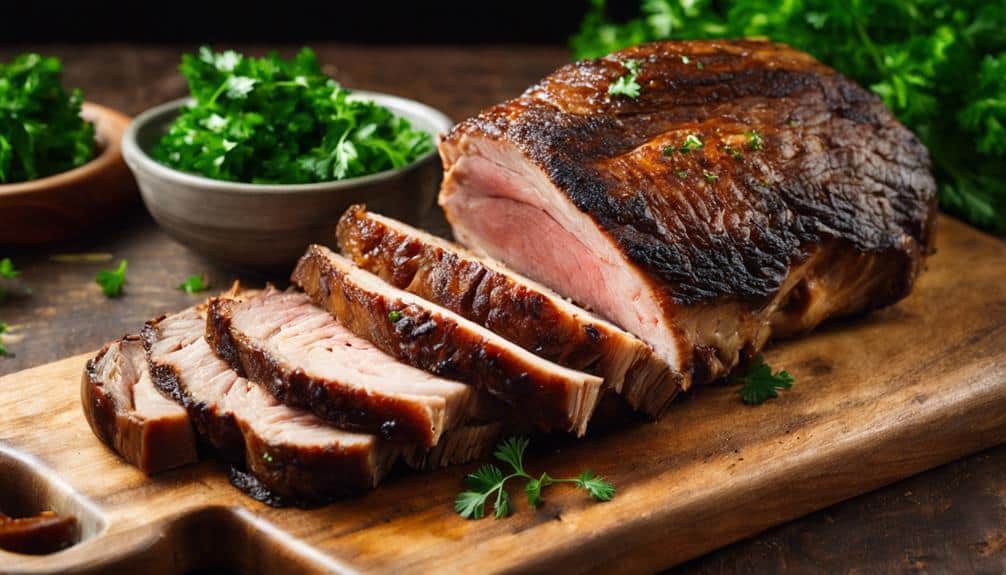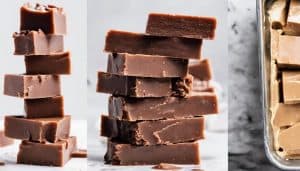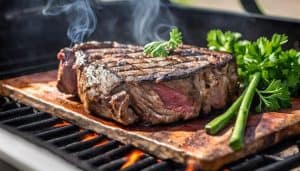You can expect to spend around 1-1.5 hours per pound of brisket, cooking low and slow at 225-250°F, to achieve tender and juicy results. Factors like size, cooking method, and desired doneness impact cooking time. For a perfectly cooked brisket, aim for an internal temperature of 203°F. Proper resting and slicing techniques are also essential for maximum tenderness. With patience and attention to temperature control, you'll be on your way to a mouthwatering brisket. As you explore the world of brisket, you'll uncover more secrets to achieving unparalleled flavor and texture.
Key Takeaways
• Cooking time varies based on brisket size, cooking method, and desired doneness, but plan for 1-1.5 hours per pound at 225-250°F.
• Internal temperature should reach 203°F for a well-done brisket, and a meat thermometer ensures accurate readings.
• A proper resting period of at least 20 minutes allows juices to redistribute, enhancing flavor and tenderness.
• Slicing against the grain and thinly slicing can further enhance tenderness and juiciness.
• Low and slow cooking at 225-250°F breaks down connective tissues, resulting in tender and flavorful brisket.
Factors Affecting Cooking Time
When you're preparing to cook a brisket, several key factors will influence the overall cooking time, and understanding these variables is important to achieving tender, fall-apart results. One of the most significant factors is the size and weight of the brisket, which will determine the cooking time. Typically, you can expect to cook a brisket for 1-1.5 hours per pound at 225-250°F.
However, the cooking method you choose will also impact the overall cooking time. Smoking, roasting in the oven, or using a slow cooker will all yield different results.
The type of smoker you use, the consistency of the temperature, and the resting period post-cooking can also influence the brisket's tenderness and cooking time.
Keep in mind that brisket may experience a stall, where the internal temperature plateaus during cooking, extending the overall cooking time. To avoid this, it's essential to monitor the internal temperature with a meat thermometer, ensuring the brisket reaches the desired doneness, typically around 195-203°F for a tender result.
Cooking Methods for Brisket
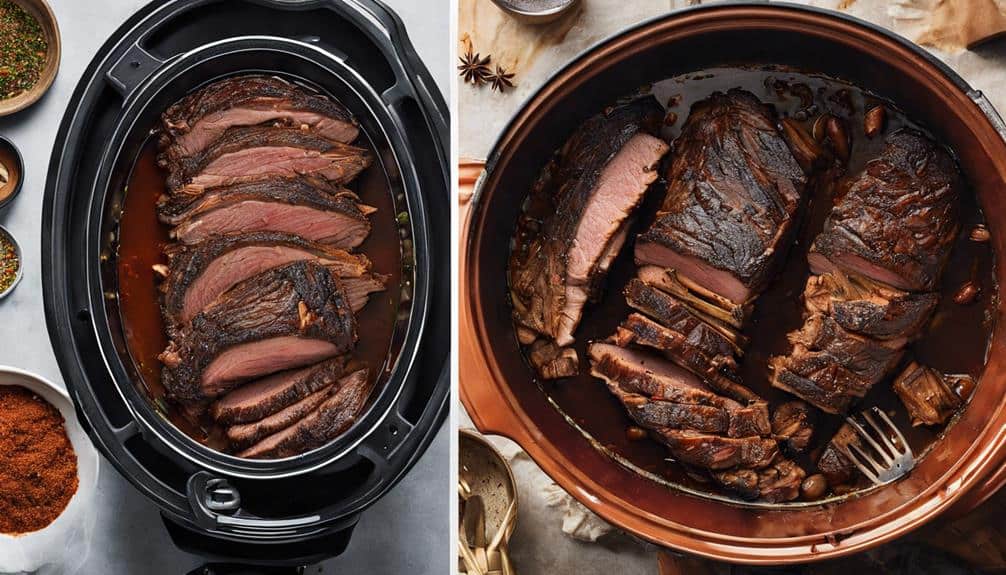
To achieve tender, fall-apart brisket results, it's crucial to employ various cooking methods, each with its own unique benefits and time requirements. When you opt for slow cooking, you'll allow the connective tissues to break down, resulting in a tender and flavorful meat that's simply irresistible. This method is perfect for those who want to cook their brisket for 8-10 hours in a slow cooker, ensuring that every bite is packed with juiciness.
If you're short on time, a pressure cooker can cook your brisket to perfection in just 1 hour and 15 minutes. Alternatively, oven-cooking is another great option, requiring around 5 hours of cooking time.
Regardless of the method you choose, it's vital to cook your brisket until it reaches an internal temperature of 203°F for a well-done texture.
Once your brisket is cooked to perfection, remember to slice it against the grain to maintain tenderness and juiciness in each bite. This simple step will elevate your dish from good to great, and your guests will thank you for it.
Temperature and Internal Readings
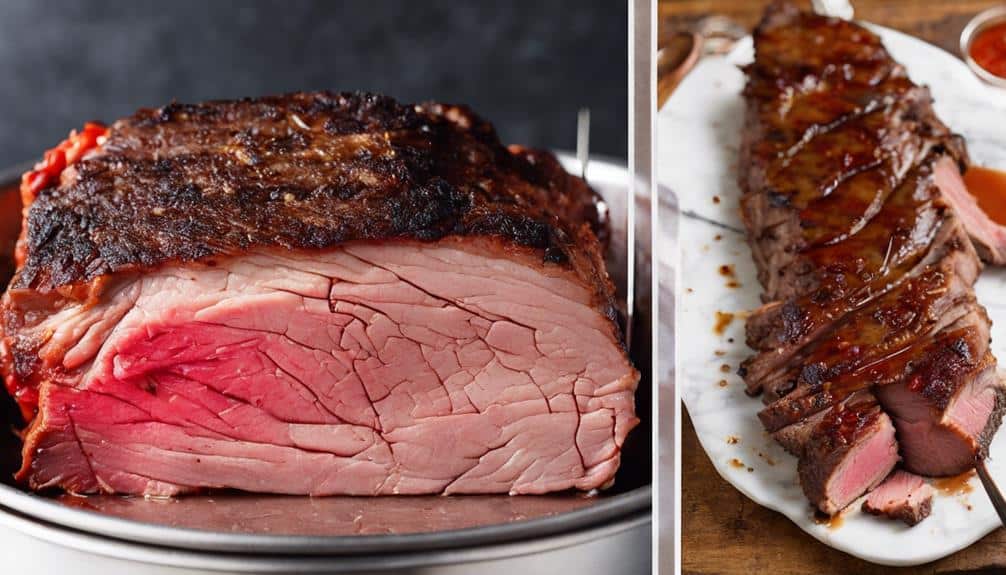
To guarantee your brisket is cooked to perfection, it's important to monitor its internal temperature, as this will determine the final texture and flavor of the meat. Cooking a brisket at a low temperature of 225-250°F is key to achieving tender results. You'll want to aim for an internal temperature of 203°F for a well-done brisket.
Here's a breakdown of the cooking time and internal temperature you can expect:
| Cooking Time | Internal Temperature |
|---|---|
| 5 hours per pound | 190°F – 195°F (Medium-Rare) |
| 5 hours per pound | 195°F – 200°F (Medium) |
| 5 hours per pound | 200°F – 203°F (Medium-Well) |
| 5 hours per pound | 203°F (Well-Done) |
Using a meat thermometer ensures accurate internal temperature readings, guaranteeing your brisket is cooked to your liking. Remember, cooking time will vary depending on the size of your brisket, so be sure to plan accordingly. By following these guidelines, you'll be on your way to a perfectly cooked brisket that's sure to impress.
Resting and Slicing Techniques
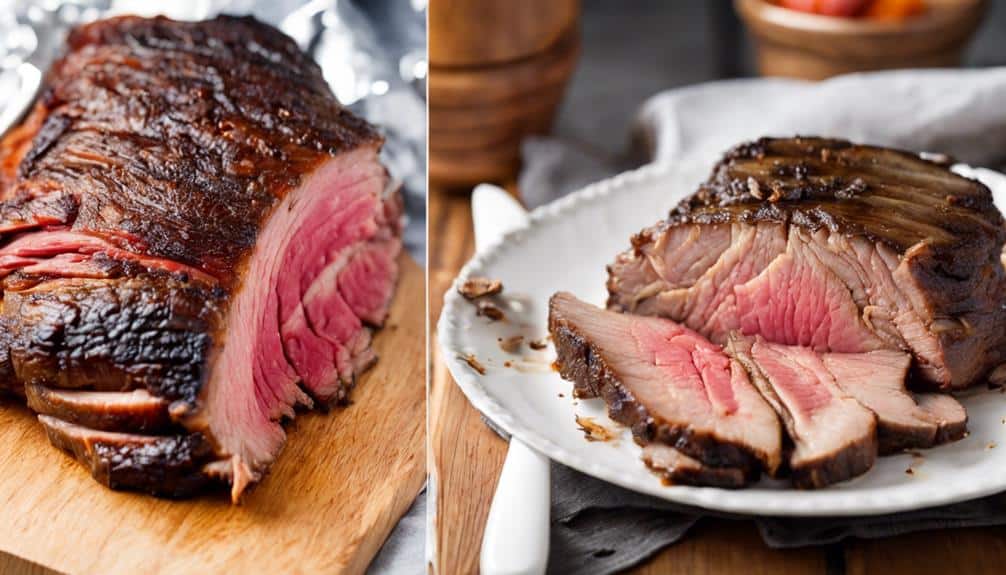
Now that you've cooked your brisket to perfection, it's time to focus on the essential steps that'll make it truly unforgettable: resting and slicing.
You'll need to master these techniques to reveal the full flavor and tenderness of your brisket.
Resting the Brisket Properly
After investing time and effort into cooking your brisket to perfection, letting it rest for at least 20 minutes is essential to allow the juices to redistribute, ensuring tender, flavorful results. During this time, your brisket continues to cook, and its internal temperature can rise by 5-10 degrees Fahrenheit.
This pivotal step allows the juices to redistribute, making your brisket even more tender and flavorful. As you let your brisket rest, it will also firm up slightly, making it easier to slice thinly without falling apart.
When you finally slice your brisket, you'll be rewarded with maximum tenderness in each bite. Proper resting is a key factor in serving a flavorful and tender brisket to your guests.
Slicing Against the Grain
When you slice your brisket, you'll get the most tender results by cutting against the grain, which means identifying the lines of muscle fibers and cutting perpendicular to them. This important step guarantees a tender bite and prevents the meat from becoming stringy and tough.
By resting your brisket for at least 20 minutes before slicing, you allow the juices to redistribute, maximizing flavor and tenderness. Slicing against the grain helps break down the muscle fibers, making the meat easier to chew and more enjoyable. This technique creates shorter muscle fibers, which is key to a tender and delicious brisket.
Proper resting and slicing against the grain are essential steps to ensure a mouthwatering brisket. By following these techniques, you'll achieve a truly exceptional dish that will impress even the most discerning palates. Remember, slicing against the grain is a game-changer, and with practice, you'll become a master of tender and flavorful brisket.
Thinly Slice for Tenderness
To achieve tender, fall-apart slices, you'll want to thinly slice your brisket. This technique, combined with proper resting, is essential for breaking down the tough muscle fibers and revealing the full flavor potential of your slow-cooked brisket.
Here are the key takeaways for achieving the best results:
- Rest for 20 minutes: Let your brisket rest for at least 20 minutes to allow the juices to redistribute, ensuring peak tenderness.
- Slice against the grain: Cutting your brisket against the grain helps to break down the tough muscle fibers, resulting in a tender bite.
- Slice thinly: Avoid cutting your brisket too thick, as this can result in chewy, less tender slices.
Brisket Size and Cooking Time
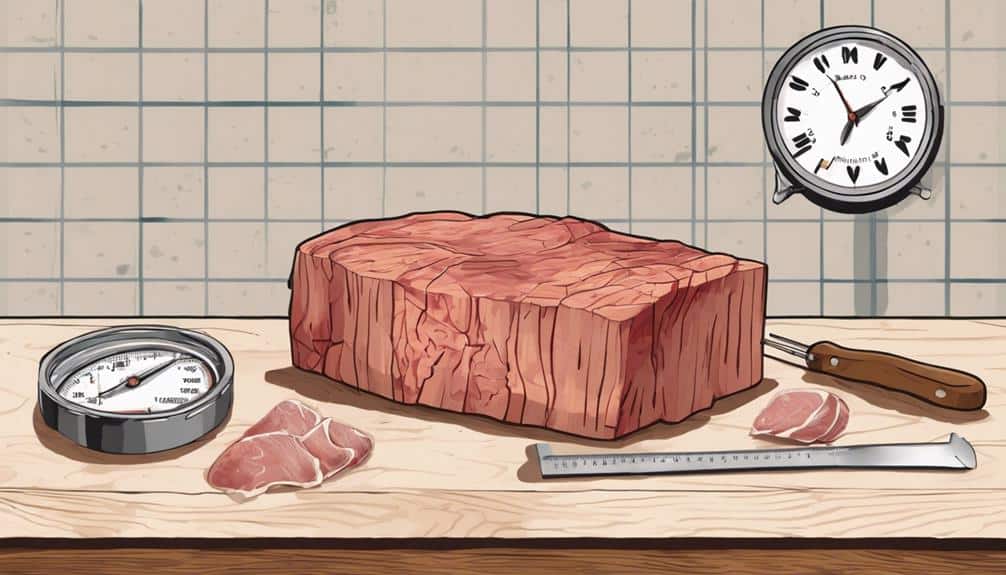
When cooking brisket, it's crucial to consider the cooking time based on its size. A general recommendation is 8 hours at 225°F for a 12-13 pound beef brisket. However, the cooking time may vary depending on the brisket's size and the preferred level of doneness. Keep in mind that the stall phase, where the internal temperature of the brisket plateaus between 145°F and 165°F, can impact the overall cooking duration.
During the wrapped smoke phase, which can last 5-8 hours, the brisket will absorb delicious flavors. The total cooking time can range from 12-18 hours, so patience is important.
Following cooking, it's vital to allow the brisket to rest for at least an hour before slicing. This resting period allows the juices to redistribute, resulting in tender and flavorful meat.
Low and Slow Cooking Methods
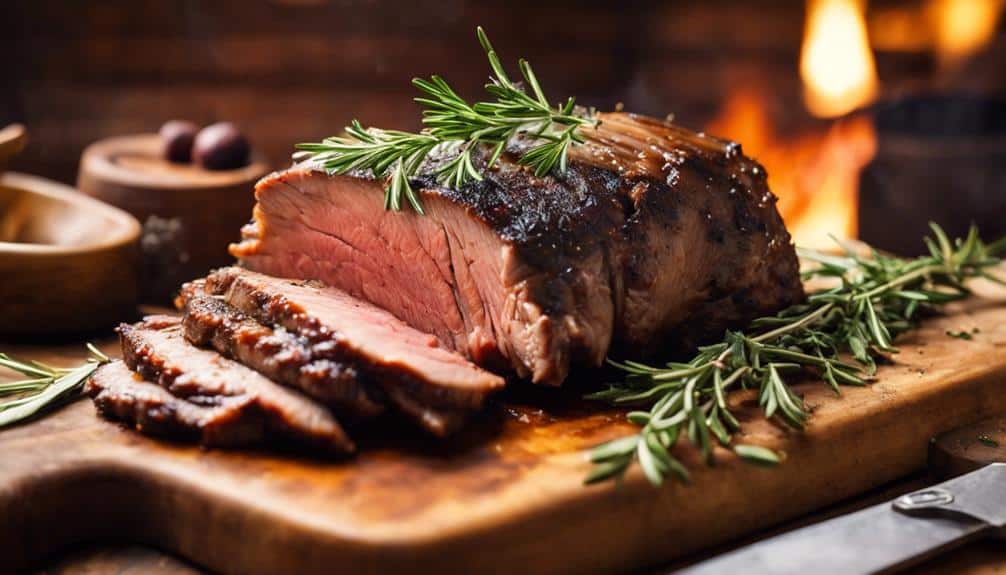
As you explore low and slow cooking methods, you'll soon realize that mastering the art of smoking a brisket low is essential for tender, fall-apart results.
You'll need to grasp the importance of temperature control, ensuring your smoker stays within the ideal range.
Smoking the Brisket Low
Smoking a brisket low and slow is a game-changer, transforming this tougher cut of meat into a tender, juicy, and flavorful masterpiece. By cooking at a low temperature of 225-250°F for an extended period, you'll be rewarded with a mouthwatering result.
Here's what you need to know:
- Temperature control: Cook your brisket at 225-250°F for 1 to 1.5 hours per pound.
- Breakdown of connective tissues: The low and slow method allows the connective tissues to break down slowly, resulting in a tender and flavorful end product.
- Internal temperature and resting: Make sure your brisket reaches an internal temperature of 195-205°F, then let it rest for at least 30 minutes to redistribute the juices.
Temperature Control Matters
You'll need to maintain a consistent temperature between 225-300°F to maximize the full potential of low and slow cooking methods, guaranteeing your brisket turns out tender and flavorful. This temperature range allows for a gradual breakdown of connective tissues, making the meat tender and juicy.
As you cook, keep in mind that the general guideline is about 1-1.5 hours per pound at a consistent temperature. However, cooking times can vary based on the size of the brisket and the desired level of doneness. To ensure peak results, use a meat thermometer to monitor the internal temperature, aiming for 180-200°F for tenderness and optimal texture.
Once cooked, remember to let the brisket rest for at least 20 minutes before slicing, allowing the juices to redistribute and the meat to relax. By controlling the temperature and cooking time, you'll be rewarded with a deliciously tender and flavorful brisket that's sure to impress.
Time and Patience
When embracing low and slow cooking methods, it's important to dedicate yourself to a prolonged cooking time. Every hour is essential in breaking down the brisket's connective tissues and revealing its full flavor potential. Cooking a brisket requires patience, and you'll need to plan for around 1 to 1.5 hours of cooking time per pound of brisket. Yes, you read that right – a 12-13 pound brisket can take anywhere from 12 to 18 hours to cook thoroughly.
Here are some key considerations to keep in mind:
- Temperature: Cook your brisket at a low temperature of 225-250°F to ensure tender, fall-apart meat.
- Cook Time: Plan for 1-1.5 hours of cooking time per pound of brisket to achieve best tenderness.
- Internal Temperature: Guarantee the internal temperature reaches 195-203°F for a perfectly cooked brisket.
What is the Recommended Cooking Time for Brisket in the Oven?
When cooking brisket in oven, the recommended cooking time is usually about 1 hour and 15 minutes per pound at a temperature of 250°F. This slow cooking method allows the meat to become tender and juicy, resulting in a flavorful and delicious brisket.
Achieving Tender and Juicy Results
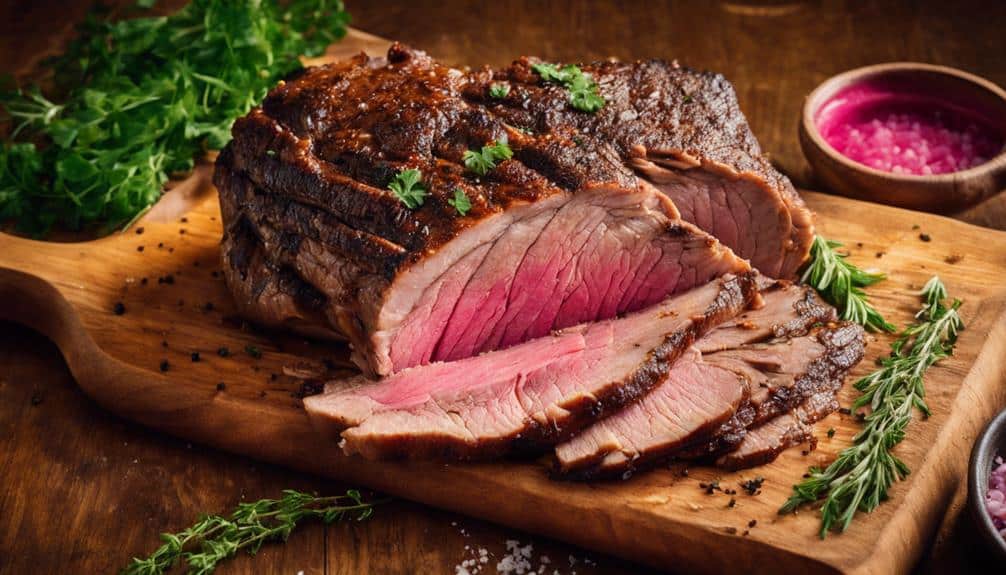
By carefully controlling the cooking time and temperature, you can coax even the toughest brisket into tender and juicy submission. To achieve ideal tenderness and juiciness, you'll need to cook your brisket low and slow, with a cook time of around 1 to 1.5 hours per pound at a temperature of 225-250°F. For an 8-10 pound brisket, plan for 8-10 hours of cooking time to make sure it reaches the desired internal temperature of 195-205°F.
During the cooking process, it's important to monitor the internal temperature to avoid overcooking, which can lead to dryness and toughness. Once you've reached the desired internal temperature, remove the brisket from the heat and let it rest for at least 20-30 minutes. This vital step allows the juices to redistribute, enhancing flavor and tenderness.
When slicing your brisket, make sure to slice against the grain to maintain its tenderness and juiciness. By following these guidelines, you'll be rewarded with a tender, juicy, and flavorful brisket that's sure to impress.
Frequently Asked Questions
How Many Hours Do It Take to Cook a Brisket?
You're wondering how many hours it takes to cook a brisket. The answer depends on the size of your brisket and the temperature you're cooking at. Generally, you're looking at around 1.5 to 2 hours per pound at 250°F to 300°F.
What Is the 3/2:1 Rule for Brisket?
As you begin your brisket-smoking journey, you've likely heard of the 3/2:1 rule. Imagine tender, flavorful meat that simply falls apart. This sacred ratio is the key to achieving it.
The 3/2:1 rule involves smoking for 3 hours unwrapped, 2 hours wrapped, and 1 hour unwrapped to complete. This technique guarantees a perfectly balanced brisket, with a tender interior and a flavorful, caramelized crust.
How Long to Cook a Brisket at 225?
You're wondering how long to cook a brisket at 225°F. The answer lies in the meat's weight. For every pound, plan on 1.5 hours of cooking time.
So, for a 12-pounder, that's around 18 hours. Remember, the key is to reach an internal temperature of 200-205°F for tenderness.
Don't rush it – low and slow is the way to go for a fall-apart, flavorful brisket.
How Long to Cook 5 Lb Brisket at 325 Degrees?
'Practice makes perfect,' and when it comes to cooking a 5-pound brisket at 325 degrees Fahrenheit, you'll want to plan ahead. Expect to spend around 3.5 to 4.5 hours in the kitchen, ensuring the internal temperature reaches 195-205 degrees Fahrenheit.
Don't forget to rest the brisket for 20-30 minutes before slicing against the grain. With patience and precision, you'll be rewarded with tender, juicy results that will impress even the most discerning palates.
Conclusion
You've mastered the art of cooking a brisket, a feat worthy of a medieval knight's accolades! With a solid grasp on factors affecting cooking time, cooking methods, and temperature control, you're ready to unveil a tender, juicy brisket upon the world.
Remember, patience is key – low and slow is the way to go. So, don your apron, sharpen your knife, and get ready to slice into a culinary masterpiece that'll make the gods smile.
